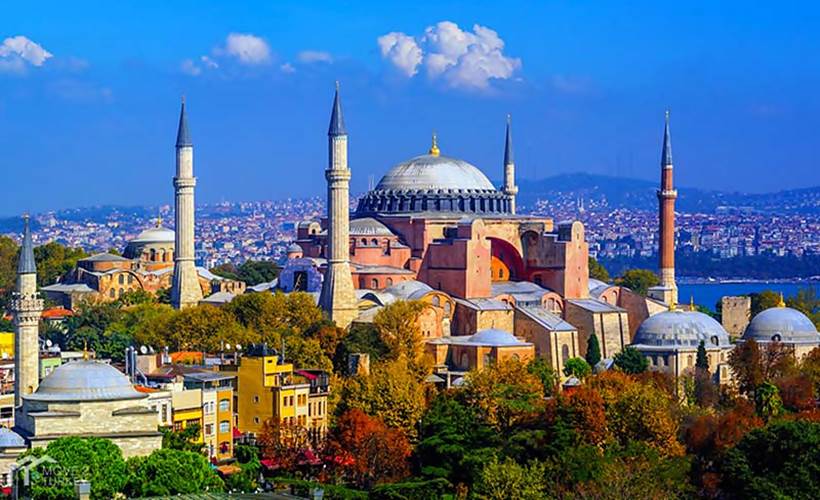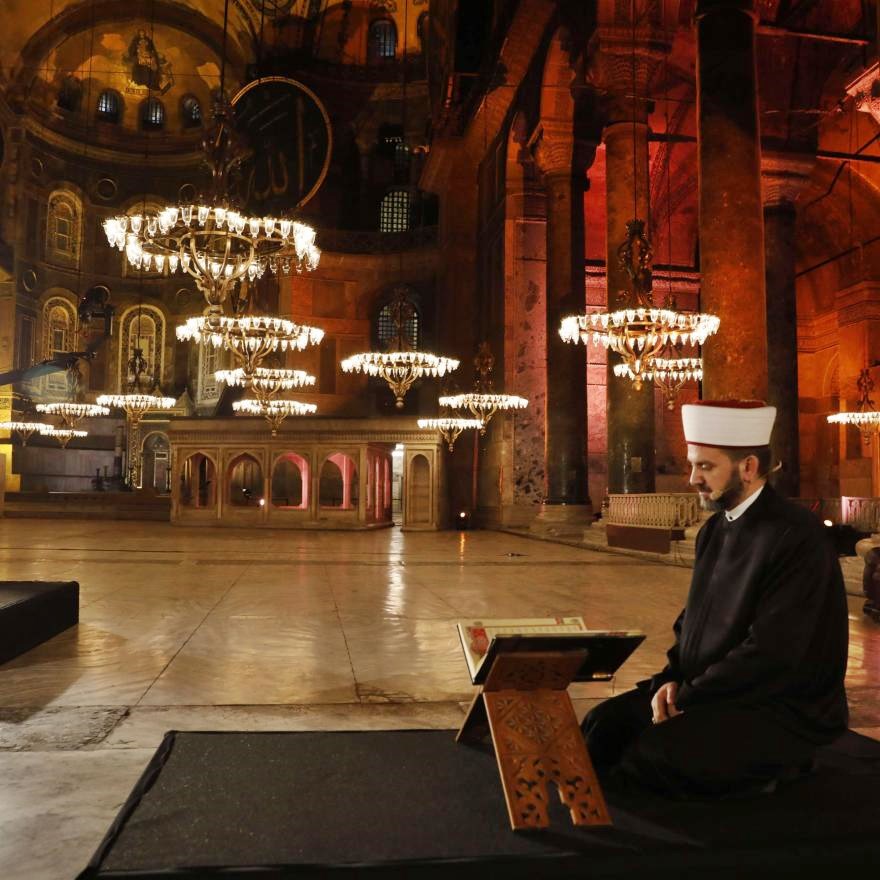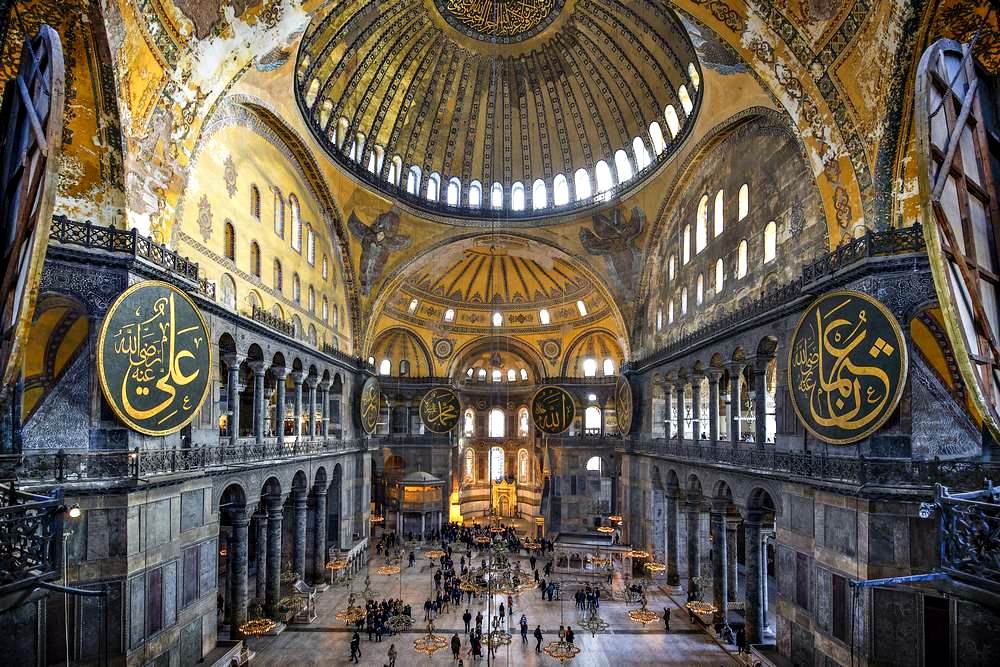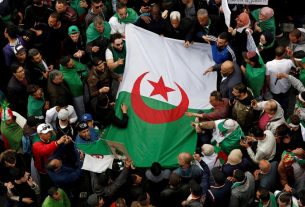Fri 10 July 2020:
A Turkish court said on Friday it annulled a 1934 government decree turning the iconic Hagia Sophia into a museum, ruling it was unlawful, paving the way for Istanbul’s grandest structure to be used as a mosque after an 85-year hiatus.
The ruling was made by the Council of State, Turkey’s top administrative court.
An hour after the court ruling, President Tayyip Erdogan declared Istanbul’s Hagia Sophia open to Muslim worship on Friday.
“The decision was taken to hand over the management of the Ayasofya Mosque…to the Religious Affairs Directorate and open it for worship,” the decision signed by Erdogan said.
An NGO in Istanbul, the Permanent Foundations Service to Historical Artifacts and Environment Association, had filed a petition at the Council of State seeking annulment of the decision to convert Hagia Sophia into a museum after being a mosque for nearly 500 years.
The court heard the parties’ arguments at a July 2 hearing before issuing its ruling.
Hagia Sophia, the largest church built by the Eastern Roman Empire in sixth-century Istanbul, was built and rebuilt three times at the same site, according to information compiled by Anadolu Agency reporters.
The religious structure built in the city then known as Byzantium where Hagia Sophia is located – ruled by the Greeks (660 BC – A.D. 73) – was destroyed by the Roman Emperor Septimius Severus.
Under the Roman Empire, the Emperor Constantine II (son of Constantine, the first Christian emperor) in 360 constructed the building in the same spot in the city – then renamed Constantinople, and the capital of the empire – and it was called Hagia Sophia (Holy Wisdom).
The first Hagia Sophia was largely destroyed 44 years after its construction during an uprising when a silver-plated statue of Empress Eudoxia, the wife of Emperor Arcadius, was erected in front of the iconic building.
Emperor Theodosius II, who succeeded Arcadius, rebuilt Hagia Sophia as designed by architect Ruffinos and opened the building to worship in 415.
The second Hagia Sophia existed as the largest church in the city for 117 years until 532, when it was destroyed by the Nika riots during the reign of Emperor Justinian.

Rebuilt in less than 6 years
Just 39 days after the riots, Justinian took to constructing the modern version of Hagia Sophia.
The construction of this Hagia Sophia – the one we know now – started in 532 and was completed in 537.
The construction was directed by two famed scholars of the era, physicist Isidore of Miletus and mathematician Anthemius of Tralles, both hailing from around Aydin in modern Turkey’s Aegean region.
Some 100 architects working with the two chief architects and 100 workers at the disposal of each architect completed the construction of the building in an impressively short period of five years and 10 months.
In the construction of the third Hagia Sophia, bricks were used instead of wooden materials as they are strong and resistant to environmental damage and fire.
Materials from across the empire
Justinian asked the governors and kings under his administration to send the most beautiful materials from their homelands to build the great church. Columns, frames, and window bars were removed from temples, baths, and palaces from all over the empire and brought to Istanbul.
These materials were drawn from ancient cities and monuments, including the Belkis ruins on the shores of Kizikos (Aydincik-Kapudaii Peninsula), the ancient city of Aspendos – both in Turkey’s Mediterranean region – as well as the Shrine to Artemis in Ephesus (Ayasuluk-Selcuk) in Turkey’s Aegean region, Baalbek (Heliopolis) in Lebanon’s Bekaa Valley, and other ancient ruins from Syria and elsewhere.
For the construction of Hagia Sophia’s famed dome, soil from the island of Rhodes – just southwest of Turkey’s coast – was chosen for its lightness. Bricks molded from this soil were prepared by the governor of Rhodes and sent quickly for the house of worship.
The details of the interior of Hagia Sophia were as dazzling as its dome, still an architectural feat.
The opening ceremony of Hagia Sophia was held around Christmastime, on Dec. 27, 537, with the participation of Emperor Justinian himself.
The eastern side of Hagia Sophia, whose dome was damaged by an earthquake 20 years after its construction, collapsed in 558. The dome was repaired by Isidore the Younger, the nephew of one of the original architects.
During the Fourth Crusade, during the sacking of the city by Christians, Hagia Sophia was also plundered. In this period, Hagia Sophia was turned into a cathedral attached to the Roman Catholic Church.
On May 16, 1204, the Latin Emperor Baldwin II had his coronation in Hagia Sophia.
When Hagia Sophia came under the control of the Byzantines again in 1261, it was in a state of ruin.
Emperor Andronicus III Palaeologus added four retaining walls to the northern and eastern parts of the building.
Since its construction, Hagia Sophia has been damaged and rebuilt due to many natural disasters as well as neglect, invasions, and wars.

Symbol of conquest
After serving as a church for 916 years, Hagia Sofia was converted into a mosque with the conquest of Istanbul by Mehmet II, the seventh sultan of the Ottoman Empire, on May 29, 1453.
Having received the title “Conqueror,” Fatih Sultan Mehmet did Friday prayers in Hagia Sophia on June 1, 1453, the first Friday after the conquest.
The value that Byzantium had placed on Hagia Sophia continued under the Ottomans. In the Ottoman era, the sultans esteemed Hagia Sophia highly, and spared no expense in order to preserve and keep Hagia Sophia, the “Symbol of Conquest.”
After converting Hagia Sophia into a mosque, Mehmet the Conqueror founded the Hagia Sophia Mosque Foundation, where he transferred valuable sources of income.
In Hagia Sophia, Mehmet ordered the construction of a minbar (pulpit), a mihrab (niche showing the direction of Mecca), a madrasa (religious school), and library. The first minaret of Hagia Sophia was also built during the time of Mehmet, out of bricks to speed up the construction.
Sultan Beyazit II (1481-1512) ordered the addition of a mihrab made of white marble to the mosque as well as a minaret at the northeast corner.
Sultan Suleiman the Magnificent (1520-1566) donated to Hagia Sophia two lamps he brought from Hungary, a territory he had conquered in 1526.
During the reign of Selim II (1566-1574), Hagia Sophia was reinforced with external retaining structures added by famed Ottoman chief architect Mimar Sinan, one of the world’s first earthquake engineers, as it had shown signs of fatigue or weakness.
With these retaining structures, Sinan also reinforced the dome by supporting the gaps between the piers carrying the dome and the side walls with arches.
Ottoman era additions
Other buildings that were added to the Hagia Sophia during the Ottoman era include marble pulpits, a gallery opening to the sultan’s gathering place, a gathering place for the muezzin (who gives the call to prayer), and a preaching rostrum.
Sultan Murat I (1574-1595) ordered the placement of two cubes made of Bektashi stone in Bergama dating from the Hellenistic era (fourth century BC) in the main hall of Hagia Sophia.
During the reign of Ahmed I (1603-1617), extensive repair and maintenance work was carried out and a basmala (key phrase from the Quran) was inscribed on the mihrab.
Sultan Murat IV (1623-1640) ordered the interior of Hagia Sophia to be decorated with calligraphy plates.
During the reign of Ahmet III (1703-1730), the sultan’s throne in Hagia Sophia was renovated, a huge oil lamp was hung in the middle of the mosque, and repairs and maintenance were carried out.
In 1739, Sultan Mahmut I ordered the building to be restored and also ordered the construction of a library, a madrasa, an imaret (soup kitchen), and a fountain next to the building.
Selim III (1789-1807) ordered the renovation of all the carpets of Hagia Sophia, and the hanging of two plates bearing the calligraphy of Mehmet Esad Yesari.
During the reign of Mahmut II (1808-1839), the mosque saw extensive repair and maintenance work.
One of the best-known restorations of Hagia Sophia from the Ottoman era was carried out by the Fossati brothers, Swiss-Italian architects, on the orders of Sultan Abdulmejid between 1847 and 1849.
The dome, pendentives (curved triangular vaulting), and pillars were strengthened and the interior and exterior decoration was renovated. Some of the gallery mosaics on the upper floor were cleaned, the ones that had been destroyed were covered with plaster, and the mosaic motifs below were painted on this plaster.
The oil lamp chandeliers providing the lighting system were renovated. Huge round paintings by Kadi-ul asker Mustafa Izzed (1801–1877), bearing the names of famed figures in calligraphy, were renovated and hung in columns. A new madrasa and muvakkithane (place where the time for the call to prayer is determined) were built outside Hagia Sophia. Minarets were rebuilt at the same height.
Some renovation was carried out in Hagia Sophia during the reigns of later Ottoman sultans Abdulaziz (1861-1876) and Abdulhamit II (1876-1909).
Conversion into museum
As the Ottoman Empire fell and the Republic of Turkey was founded in 1923, the history of Hagia Sofia also changed.
A series of restorations were carried out at the order of Mustafa Kemal Ataturk, founder of the Republic of Turkey, between 1930 and 1935. The dome was surrounded with an iron belt and the mosaics were uncovered and cleaned.
Under a Cabinet decision dated Nov. 24, 1934 – and contested in our time – Hagia Sophia was converted into a museum.
In 1985, Hagia Sophia was added to UNESCO’s official World Heritage List.
After serving as a church for 915 years since its construction until the conquest of Istanbul in 1453, and serving as a museum since 1934, Hagia Sophia has served as a museum for 86 years and is one of the top destinations for local and foreign tourists visiting Turkey.
Since its conversion into a museum, various restoration work has been carried out in Hagia Sofia.
Call to prayer after 85 years
Following the special Muslim Night of Power (Qadr Night) on July 1, 2016, the morning azan (call to prayer) was recited in Hagia Sofia for the first time in 85 years.
An imam was appointed to the Hunkar Pavilion of Hagia Sophia, which was opened for worship that October by Turkey’s Religious Affairs Directorate.
As of 2016, prayers were performed in the Hunkar Pavilion section and the azan has been recited five times a day.
This year, as the 567th anniversary of the conquest of Istanbul was celebrated on May 29, the holy Quran’s Conquest Surah was recited in Hagia Sophia.
Anatoly Agency
Think your friends would be interested? Share this story!





